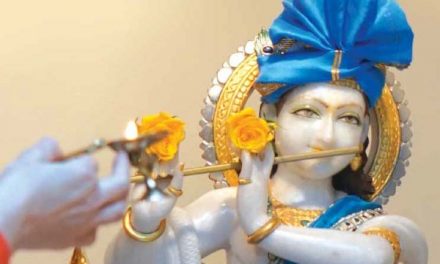 Six Chanting Practice Tips
Six Chanting Practice Tips
by Jody Tull (Jyoti)
“Kirtan melts the heart, fills the mind with purity and generates harmony and Divine Love. He who chants the name of God forgets the body and the world. The devotee enters into the superconscious state by singing devotional music.
The name of God generates God-consciousness in the purified mind and becomes the direct cause of your highest realization.” – Swami Sivananda
 If you’re reading YogaLife, chances are that you’ve already experienced chanting. Many people would like to participate more fully than they do… but they hold back, because they’re not sure if they “can”. Sharing your voice is a way of sharing your authentic and courageous self, and becoming who you were meant to be.
If you’re reading YogaLife, chances are that you’ve already experienced chanting. Many people would like to participate more fully than they do… but they hold back, because they’re not sure if they “can”. Sharing your voice is a way of sharing your authentic and courageous self, and becoming who you were meant to be.
It brings clarity of expression and clarity of thought. You can learn to fall in love with your own voice, turning singing into an enjoyable, restorative, healing form of worship. Like anything worthwhile, doing so is a process that takes discipline and time. I believe almost anyone can sing.
With 5 – 10 minutes per day of practice, you really can learn to listen more deeply developing an attitude of reverence for your voice as being precious and God-given.
Follow these six tips when practicing for 5 – 10 minutes a day
1 – Prioritize getting to know your breath. It’s your most precious asset. Squeeze out the air from your lungs, like squeezing water from a dishcloth. Pause at the end of the exhale. Round the upper back slightly forward, then focus your mind on the journey of the inhale, and fill the back of the ribcage and chest cavity with air.
Then lift from the waist and open the chest (as if in the fish pose). When you feel as though you might burst, pause at the end of the inhale. While exhaling, hum for the entire duration of the exhale. Feel as though you are gently squeezing all the muscles along the spine – lifting up from waist and opening the chest.
2 – While humming through the exhale, be aware of a vibrational charge in your body. At the end of the inhale, hum to generate a buzzing behind your nose, forehead and face, and try to extend it to your head and beyond, extending out like branches on a tree. Experiment with high medium and low pitch, loud and very soft volume and imagery, e.g. feeling as though the whole of your ajna chakra (the region between your eyebrow and behind your forehead) is a singing bowl.
Once you activate resonance in the ajna chakra (probably the most easy to feel), shift the awareness to your root (first) chakra at the base of your spine and hum to activate resonance there. Repeat the experiment in the second, (belly) third, (solar plexus) fourth (heart) and fifth (throat) chakras. Especially effective is to hum one of the charkas through the exhale of anuloma pranayama. You will notice that resonance comes easily in some of the chakra centers and not at all in others.
If you experience no resonance, it’s an indicator that you have blocked energy which will be released (by sounding) in time and with practice. This is something we explore in “Finding Your Voice”workshops. Once the supported exhale activates increased resonance through the hum in each of the chakras, you will feel more alive, present and free.
3 – Repeat exercise 2 using a supported flow of (1) vowels, A, E, I, O, U (2) consonants, L….mmm, V…..mmm, R…..mmm, Y…..mmm, (3) mantras and (4) chants. A firm support comes from slightly tensing the diaphragm and intercostal (rib) muscles; it feels a bit like squeezing toothpaste out of the tube. Think of your body as being like a sounding board, like the whole of a harp or bass violin or tabla drum. I like to think of the inhale as being like the tide of the ocean going in, and, the exhale as being like the tide of the ocean going out.
To increase resonance even more, experiment with signi – ficantly dropping the jaw and rounding the lips in order to shape and resonate the Oooom sound. At first the vibrational buzz might feel diminished… but it’s only an adjustment into activating sound with the mantra. Experiment with different sound sequences: Om moves into Aaaaaoooooommmmm… to Ma Oooom… to Om Namo Narayanaya… to Om Nama Sivaya. Remember to set up the sound and to frame the sound with the silence of your elongated inhale.
By enjoying and resting in the silence of the inhale, you become increasingly aware of your sound riding out your exhale, like a surf board riding the waves of the ocean. You’ll soon notice you are no longer fearful of what others will think, more tuned into and trusting of your inner voice.
4 – Improvise in the space of one exhale, changing pitch between sliding from high down to low, or low up to high to form a melody – not just listening through your ears, but listening with your whole body. Inhale deeply and then improvise (enjoying whatever rhythms and pitches come out) while singing your name 3 times. And again. Imagine listening from your root chakra, then from each of the other chakras.
Notice how your body receives and digests the sound ripping the chakra through one exhale. Long pause, long relaxing inhale and repeat the experiment again. Discover yourself resonating silly, playful, mournful, even outrageous sound sequences through the duration of one long exhale. Sometimes your sounding will activate important and powerful releases. Don’t be surprised or put off by an outpour of tears or laughter. This is good!! Guaranteed, you’ll feel completely refreshed and clean…lIt’s like you’ve given the inside of your body a shower. Jiggle and drop your jaw, tense and relax your shoulders, neck, face and other body parts as you would do in a yoga class. Aim for the relaxed sensation of savasana.
Think of Krishna’s flute – pure unobstructed energy pouring through the instrument. As you become more comfortable singing and expressing your authentic self, you become the instrument!! Become aware of the sound singing you and of creative ideas bursting in your second chakra.
5 – Begin to build your chanting repertoire by choosing several favourites to learn by heart and sing throughout the day. It is not required, but very helpful and rewarding, to have an ally or two, who will, on a regular basis, sing with you. Better yet, in addition to attending Sivananda Satsang, establish a neighbourhood weekly singing circle. Teach each other your favourite chants and songs, welcoming in an abun – dance of silence and gratitude as you come together in worship.
During Kirtan singing, I have formed the habit of inhaling deeply as I silently connect to the sung call. It’s the best way I’ve found to stay present, practice the deep listening during the inhale while connecting to the divine intention of the solo singer. By doing so, I’m primed to express the response through my sounded exhale.
6 – Enjoy!!!! Let go of the temptation to judge your sound. Instead, tune in deeply and be in awe!! Attend Sivananda Satsang and volunteer to lead a chant. During moments that require a lot of courage (like leading a chant for the first time) or tense moments at home or at work, be aware of a silent om resonating you at the base of your spine. This will ground you and relax tense vibes and work miracles in trans – forming the tension into calm.
Jody Tull (Jyoti) is a composer and performer with an MA in Music from Columbia University; she is also an experienced yogi and heads a local Sivananda affiliated Centre. She has combined her expertise in music and yoga to develop techniques that help people who do not yet love and respect their own voices. Her website: www.beinawe.com































